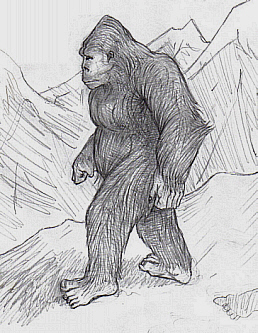T.G.G. Moogly
Traditional Atheist
In 1929, J.W. Burns, a Canadian government agent, published an article in Maclean's magazine titled Introducing B.C.'s Hairy Giants, which he wrote based on stories shared by Sts'ailes community members he'd befriended. The article presented Sasquatch to the rest of Canada, and the tale took off from there.
This intersection of Sasquatch as symbolic totem, and Sasquatch as living primate, has taken the story beyond mere speculation in Harrison Hot Springs. The town has become a magnet for those seeking answers, like the 26 percent of Canadians that believe cryptids such as Sasquatch are "definitely" or "probably" real, according to an Angus Reid Institute public opinion poll from 2016.
The True Origin of Sasquatch
It would seem that the peoples of northwestern North America have for millennia venerated a mythical creature that was a shapeshifter and shepherd of the forest.
As Charlie explained, Sts'ailes tradition holds that the creature can change from its physical form to a rock, tree or even another animal. "My grandpa used to say, 'The slollicum is a shapeshifter and can walk in the two realms, the spiritual and the physical. That's why you'll never catch him,'" he said.
Richard Carrier would correctly argue that the legend of Sasquatch has been euhemerized as the primate Bigfoot.
Ultimately, seeing Sasquatch is considered a blessing and a sign of good luck, Charlie's grandfather used to say. "If you're able to see him, hear him or see his footprints, there's some type of good fortune that's going to come your way because he's making sure that you know that he's there and that you still have to live by the rules," said Charlie, referring to the agreement between humans and sasq'ets to live in harmony with nature. "They live off the land, they live on the land, they are the land."
So a particular town is granted money and graced with pilgrims because people have questions and are curious about stories concerning Bigfoot. Of course most will go there not knowing that Bigfoot is the incarnation of a local myth.
There have been 37 notable Sasquatch sightings near the town of Harrison Hot Springs since 1900. Called Bigfoot in the United States, and yeti or metoh kangmi ("wild man of the snows") in the Himalaya, Sasquatch is a tall, hairy, bi-pedal, primate-like creature of disputed existence. Regular sightings have kept the popular legend alive, but now it's being told from an Indigenous perspective. The change is driven by public interest in the idea of a Sasquatch rooted in spirituality and symbolism, rather than sensationalism. The creature is considered sacred to West Coast First Nations, particularly the Sts'ailes (sta-hay-lis), who have lived in the Harrison River Valley for at least 10,000 years.
And we have Bigfoot by another name all over the world, many sightings right here in my home state of Pennsylvania. Some people are convinced there are families of Bigfoot residing on their properties. Some scientists are actually searching for the real Bigfoot, the giant, hairy, bipedal creature that is not the creature of legend but that is as real as any other secretive organism.
Who knows, in a couple thousand years we may be reading the synoptic gospels of Bigfoot, not such a far out notion considering all the scientific illiteracy and superstitious nonsense that passes as fact. Gotta wonder.
Sasquatch/Bigfoot/Yeti/Swamp Ape are all mythical creatures but hundreds of millions of humans believe that the creatures are flesh and bone real. It really puts one to mind about the early stories about Jesus, the similarity is unmistakable. In a very real way, for believers, Bigfoot just can't be bested, you just can't pin him down. He triumphs no matter what.

